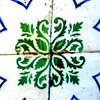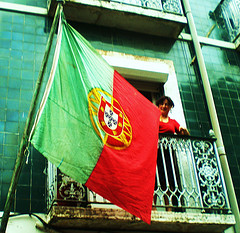 Yesterday I decided to have a clear-out and in the process I found a tiny Portuguese flag pin that a friend gave me a few years ago. As someone who has worked a lot with symbolism I became fascinated with the design of the flag and curious to find out what it meant.
Yesterday I decided to have a clear-out and in the process I found a tiny Portuguese flag pin that a friend gave me a few years ago. As someone who has worked a lot with symbolism I became fascinated with the design of the flag and curious to find out what it meant.
Firstly the main colours of the flag are red and green. The green takes up two fifths of the flag and the green, three fifths. An armillary sphere is placed over where the two colours meet and over that lies the shield of Portugal.
The flag itself has been in use since 1910 when the monarchy of Portugal were overthrown. However, it was not until 1911 that the flag as it flies today was agreed officially and there was much argument around its design in that intervening year.
Previously, the colours of the flag were mostly blue and white which celebrated the royal family. It was natural therefore that these colours were changed to those of the republican party. Red to represent the blood of the Portuguese (and those who had died defending their country) and green to represent hope and optimism in a new era of republicanism.
 Photo by MadalenaPestana on Flickr
Photo by MadalenaPestana on Flickr
The armillary sphere represents Portugal’s great history of maritime discoveries. The sphere was used to navigate the oceans and was incorporated in the personal banner of King Manuel 1st who reigned during those magnificent times. The architecture of the era often included the armillary sphere as well. You can see examples on Belém Tower and in the Monastery of Jerónimos.
Lastly on the flag is the shield of Portugal which sits on top of the armillary sphere. The shield has been present on almost every flag of Portugal (if in slightly differing designs). In the centre of the shield are five small blue shields with five dots in each. The dots are called ‘bezants’. A bezant is an old coin which comes from the word “Byzantian” as these gold coins were the most prized.
It is believed that these five bezants represent the five Moorish Kings that were overthrown by Afonso 1st. Afonso was given a vision that told he would conquer the opposing kings even though their armies outnumbered his. Whether or not this is historically true remains in question but it is said that he included the five bezants to remember this divine victory and honour the five wounds of Christ. The thirty byzants in total are meant to recall the thirty pieces of silver that Judas received for selling out his friend Jesus.
Seven castles on a red background surround the central blue shields and these are supposed to represent Afonso 3rd’s victory over seven Moorish kings.
Much of the truth behind these symbols is lost to history and arguments continue today over what they really represent. Like any good symbol, the images used evoke certain meanings and emotions and it is they that are the most important. Here is a land full of passion, hope and loyalty, a land with a history of discovery, a willingness to take a risk and overcome the odds. The colours are strong and proud like the land it flies above.
For a more comprehensive history check out Wikipedia’s entry on the Flag of Portugal

8 comments for “The Portuguese Flag”